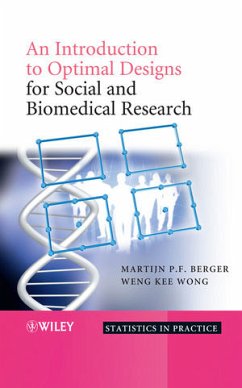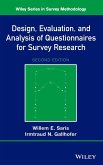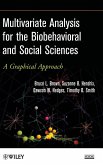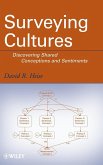Martijn P F Berger, Weng-Kee Wong
An Introduction to Optimal Designs for Social and Biomedical Research
Martijn P F Berger, Weng-Kee Wong
An Introduction to Optimal Designs for Social and Biomedical Research
- Gebundenes Buch
- Merkliste
- Auf die Merkliste
- Bewerten Bewerten
- Teilen
- Produkt teilen
- Produkterinnerung
- Produkterinnerung
The increasing cost of research means that scientists are in more urgent need of optimal design theory to increase the efficiency of parameter estimators and the statistical power of their tests. The objectives of a good design are to provide interpretable and accurate inference at minimal costs. Optimal design theory can help to identify a design with maximum power and maximum information for a statistical model and, at the same time, enable researchers to check on the model assumptions. This Book: * Introduces optimal experimental design in an accessible format. * Provides guidelines for…mehr
Andere Kunden interessierten sich auch für
![Design of Questionnaires 2E Design of Questionnaires 2E]() Willem E. SarisDesign of Questionnaires 2E105,99 €
Willem E. SarisDesign of Questionnaires 2E105,99 €![Advances in Comparative Survey Methods Advances in Comparative Survey Methods]() Advances in Comparative Survey Methods160,99 €
Advances in Comparative Survey Methods160,99 €![Agent-Based Computational Sociology Agent-Based Computational Sociology]() Flaminio SquazzoniAgent-Based Computational Sociology94,99 €
Flaminio SquazzoniAgent-Based Computational Sociology94,99 €![Multivariate Analysis Social S Multivariate Analysis Social S]() Bruce L BrownMultivariate Analysis Social S142,99 €
Bruce L BrownMultivariate Analysis Social S142,99 €![Behavioral Computational Social Science Behavioral Computational Social Science]() Riccardo BoeroBehavioral Computational Social Science92,99 €
Riccardo BoeroBehavioral Computational Social Science92,99 €![Survey Methods in Multinational, Multiregional, and Multicultural Contexts Survey Methods in Multinational, Multiregional, and Multicultural Contexts]() Survey Methods in Multinational, Multiregional, and Multicultural Contexts120,99 €
Survey Methods in Multinational, Multiregional, and Multicultural Contexts120,99 €![Surveying Cultures Surveying Cultures]() David R. HeiseSurveying Cultures136,99 €
David R. HeiseSurveying Cultures136,99 €-
-
-
The increasing cost of research means that scientists are in more urgent need of optimal design theory to increase the efficiency of parameter estimators and the statistical power of their tests. The objectives of a good design are to provide interpretable and accurate inference at minimal costs. Optimal design theory can help to identify a design with maximum power and maximum information for a statistical model and, at the same time, enable researchers to check on the model assumptions. This Book: * Introduces optimal experimental design in an accessible format. * Provides guidelines for practitioners to increase the efficiency of their designs, and demonstrates how optimal designs can reduce a study's costs. * Discusses the merits of optimal designs and compares them with commonly used designs. * Takes the reader from simple linear regression models to advanced designs for multiple linear regression and nonlinear models in a systematic manner. * Illustrates design techniques with practical examples from social and biomedical research to enhance the reader's understanding. Researchers and students studying social, behavioural and biomedical sciences will find this book useful for understanding design issues and in putting optimal design ideas to practice.
Hinweis: Dieser Artikel kann nur an eine deutsche Lieferadresse ausgeliefert werden.
Hinweis: Dieser Artikel kann nur an eine deutsche Lieferadresse ausgeliefert werden.
Produktdetails
- Produktdetails
- Verlag: John Wiley & Sons / Wiley
- 1. Auflage
- Seitenzahl: 346
- Erscheinungstermin: 1. Juli 2009
- Englisch
- Abmessung: 231mm x 157mm x 23mm
- Gewicht: 612g
- ISBN-13: 9780470694503
- ISBN-10: 0470694505
- Artikelnr.: 26433098
- Herstellerkennzeichnung
- Libri GmbH
- Europaallee 1
- 36244 Bad Hersfeld
- gpsr@libri.de
- Verlag: John Wiley & Sons / Wiley
- 1. Auflage
- Seitenzahl: 346
- Erscheinungstermin: 1. Juli 2009
- Englisch
- Abmessung: 231mm x 157mm x 23mm
- Gewicht: 612g
- ISBN-13: 9780470694503
- ISBN-10: 0470694505
- Artikelnr.: 26433098
- Herstellerkennzeichnung
- Libri GmbH
- Europaallee 1
- 36244 Bad Hersfeld
- gpsr@libri.de
Martijn Berger, Department of Methodology and Statistics, University of Maastricht, The Netherlands Professor Berger has been teaching and conducting research in this area for over 20 years. He has an extensive collection of publications to his name, including articles in a wide range of journals, a contributed chapter in Wiley's recent Encyclopedia of Statistics in Behavioural Science, and the 2005 book Applied Optimal Designs, co-authored with Weng Kee Wong. Weng Kee Wong, Department of Biostatistics, University of California - Los Angeles, USA One of the leading experts in the US working in this field, Professor Wong is currently conducting grant-funded research into making optimal design methods more accessible for practitioners. As well as co-authoring Applied Optimal Designs, he has published over a hundred refereed articles, in numerous journals. He has held the position of Associate Editor for many such journals, including a current, second 3-year term for Biometrics.
Preface xi
Acknowledgements xiii
1 Introduction to designs 1
1.1 Introduction 1
1.2 Stages of the research process 4
1.2.1 Choice of a 'good' design 5
1.3 Research design 6
1.3.1 Choice of independent variables and levels 6
1.3.2 Units of analysis 6
1.3.3 Variables 7
1.3.4 Replication 8
1.4 Types of research designs 8
1.5 Requirements for a 'good' design 9
1.5.1 Statistical conclusion validity 10
1.5.2 Internal validity 12
1.5.3 Control of (unwanted) variation 13
1.6 Ethical aspects of design choice 16
1.7 Exact versus approximate designs 17
1.8 Examples 19
1.8.1 Radiation dosage example 19
1.8.2 Designs for the Poggendorff and Ponzo illusion experiments 20
1.8.3 Uncertainty about best fitting regression models 22
1.8.4 Designs for a priori contrasts among composite faces 23
1.8.5 Designs for calibration of item parameters in item response theory
models 24
1.9 Summary 26
2 Designs for simple linear regression 27
2.1 Design problem for a linear model 27
2.1.1 The design 28
2.1.2 The linear regression model 31
2.1.3 Estimation of parameters and efficiency 32
2.2 Designs for radiation-dosage example 35
2.3 Relative efficiency and sample size 36
2.4 Simultaneous inference 37
2.5 Optimality criteria 39
2.5.1 D-optimality criterion 40
2.5.2 A-optimality criterion 41
2.5.3 G-optimality criterion 41
2.5.4 E-optimality criterion 43
2.5.5 Number of distinct design points 43
2.6 Relative efficiency 44
2.7 Matrix formulation of designs for linear regression 44
2.8 Summary 49
3 Designs for multiple linear regression analysis 51
3.1 Design problem for multiple linear regression 51
3.1.1 The design 52
3.1.2 The multiple linear regression model 54
3.1.3 Estimation of parameters and efficiency 54
3.2 Designs for vocabulary-growth study 56
3.3 Relative efficiency and sample size 60
3.4 Simultaneous inference 61
3.5 Optimality criteria for a subset of parameters 62
3.6 Relative efficiency 64
3.7 Designs for polynomial regression model 65
3.7.1 Exact D-optimal designs for a quadratic regression model 69
3.7.2 Scale dependency of A- and E-optimality criteria 71
3.8 The Poggendorff and Ponzo illusion study 71
3.9 Uncertainty about best fitting regression models 76
3.10 Matrix notation of designs for multiple regression models 79
3.10.1 Design for regression models with two independent variables 80
3.10.2 Design for regression models with two non-additive independent
variables 82
3.11 Summary 85
4 Designs for analysis of variance models 87
4.1 A typical design problem for an analysis of variance model 87
4.1.1 The design 89
4.1.2 The analysis of variance model 90
4.1.3 Formulation of an ANOVA model as a regression model 91
4.2 Estimation of parameters and efficiency 95
4.2.1 Measures of uncertainty 96
4.3 Simultaneous inference and optimality criteria 97
4.4 Designs for groups under stress study 98
4.4.1 A priori planned unequal sample sizes 99
4.4.2 Not planned unequal sample sizes 100
4.5 Specific hypotheses and contrasts 101
4.5.1 Loss of efficiency and power 103
4.6 Designs for the composite faces study 106
4.7 Balanced designs versus unbalanced designs 109
4.8 Matrix notation for Groups under Stress study 109
4.9 Summary 111
5 Designs for logistic regression models 113
5.1 Design problem for logistic regression 113
5.2 The design 114
5.3 The logistic regression model 115
5.3.1 Design for a single dichotomous independent variable 116
5.3.2 Design for multiple qualitative independent variables 122
5.3.3 Design for a single quantitative independent variable 125
5.3.4 Design for two independent quantitative variables 130
5.4 Approaches to deal with local optimality 133
5.5 Designs for calibration of item parameters in item response theory
models 134
5.6 Matrix formulation of designs for logistic regression 137
5.6.1 Hours of practice experiment 138
5.6.2 Problem solving study 140
5.7 Summary 141
6 Designs for multilevel models 143
6.1 Design problem for multilevel models 143
6.1.1 The design 144
6.1.2 Validity considerations 146
6.2 The multilevel regression model 147
6.2.1 Cluster randomization of treatment 147
6.2.2 Subject randomization of treatment 149
6.3 Cluster versus subject randomization 151
6.4 Cost function 153
6.5 Example: Nursing home study 155
6.5.1 Cluster randomization 157
6.5.2 Subject randomization 159
6.6 Optimal design and power 160
6.6.1 Power for cluster randomized design 162
6.6.2 Power for multi-center design 164
6.6.3 Increase of efficiency and power by including covariates 165
6.6.4 Unequal sample sizes 165
6.7 Design effect in multilevel surveys 166
6.7.1 Values of intra-class correlation ¿ 168
6.7.2 Cluster randomized sampling versus simple random sampling 168
6.8 Matrix formulation of the multilevel model 169
6.8.1 Cluster randomization of treatment 170
6.8.2 Subject randomization of treatment 172
6.9 Summary 174
7 Longitudinal designs for repeated measurement models 175
7.1 Design problem for repeated measurements 175
7.2 The design 179
7.3 Analysis techniques for repeated measures 180
7.4 The linear mixed effects model for repeated measurement data 181
7.4.1 Random intercept model 182
7.4.2 Random intercept and slope model 183
7.5 Variance-covariance structures 184
7.5.1 Compound symmetry structure 184
7.5.2 Auto-correlation structure 185
7.6 Estimation of parameters and efficiency 187
7.6.1 Small sample behaviour of estimators 188
7.7 Bone mineral density example 189
7.7.1 Improvement of the longitudinal design 194
7.8 Cost function 196
7.9 D-optimal designs for linear mixed effects models with autocorrelated
errors 200
7.10 Miscellanea 207
7.10.1 Homoscedasticity 207
7.10.2 Uninformative dropout 208
7.11 Matrix formulation of the linear mixed effects model 208
7.12 Summary 211
8 Two-treatment crossover designs 213
8.1 Design problem for crossover studies 213
8.2 The design 216
8.3 Confounding treatment effects with nuisance effects 218
8.4 The linear model for crossover designs 221
8.5 Estimation of parameters and efficiency 223
8.6 Cost and efficiency of the crossover design 223
8.6.1 Cost function 226
8.7 Optimal crossover designs for two treatments 229
8.7.1 Some further observations 231
8.8 Matrix formulation of the mixed model for crossover designs 232
8.9 Summary 235
9 Alternative optimal designs for linear models 237
9.1 Introduction 237
9.2 Information matrix 238
9.3 DA- or Ds-optimal designs 239
9.4 Extrapolation optimal design 241
9.5 L-optimal designs 242
9.6 Bayesian optimal designs 244
9.7 Minimax optimal design 247
9.8 Multiple-objective optimal designs 250
9.8.1 Constrained optimal design 251
9.8.2 Compound optimal design 253
9.9 Summary 255
10 Optimal designs for nonlinear models 257
10.1 Introduction 257
10.2 Linear models versus nonlinear models 258
10.2.1 The Arrhenius equation 258
10.2.2 The compartmental model 259
10.2.3 The Michaelis-Menten model 260
10.2.4 The Emax model 261
10.3 Design issues for nonlinear models 261
10.3.1 Local optimality 262
10.4 Alternative optimal designs with examples 265
10.4.1 DA or Ds-optimal design 265
10.4.2 Extrapolation optimal design 266
10.4.3 Optimal design for estimating percentiles 266
10.5 Bayesian optimal designs 267
10.6 Minimax optimal design 269
10.7 Multiple-objective optimal designs 271
10.8 Optimal design for model discrimination 273
10.9 Summary 275
11 Resources for the construction of optimal designs 277
11.1 Introduction 277
11.2 Sequential construction of optimal designs 278
11.3 Exchange of design points 283
11.3.1 Exchange algorithms 283
11.4 Other algorithms 284
11.5 Optimal design software 285
11.6 A web site for finding optimal designs 286
11.6.1 Optimal designs for the Michaelis-Menten and Emax models 288
11.6.2 Optimal designs for discriminating among toxicological models 290
11.7 Summary 294
References 295
Author Index 313
Subject Index 319
Acknowledgements xiii
1 Introduction to designs 1
1.1 Introduction 1
1.2 Stages of the research process 4
1.2.1 Choice of a 'good' design 5
1.3 Research design 6
1.3.1 Choice of independent variables and levels 6
1.3.2 Units of analysis 6
1.3.3 Variables 7
1.3.4 Replication 8
1.4 Types of research designs 8
1.5 Requirements for a 'good' design 9
1.5.1 Statistical conclusion validity 10
1.5.2 Internal validity 12
1.5.3 Control of (unwanted) variation 13
1.6 Ethical aspects of design choice 16
1.7 Exact versus approximate designs 17
1.8 Examples 19
1.8.1 Radiation dosage example 19
1.8.2 Designs for the Poggendorff and Ponzo illusion experiments 20
1.8.3 Uncertainty about best fitting regression models 22
1.8.4 Designs for a priori contrasts among composite faces 23
1.8.5 Designs for calibration of item parameters in item response theory
models 24
1.9 Summary 26
2 Designs for simple linear regression 27
2.1 Design problem for a linear model 27
2.1.1 The design 28
2.1.2 The linear regression model 31
2.1.3 Estimation of parameters and efficiency 32
2.2 Designs for radiation-dosage example 35
2.3 Relative efficiency and sample size 36
2.4 Simultaneous inference 37
2.5 Optimality criteria 39
2.5.1 D-optimality criterion 40
2.5.2 A-optimality criterion 41
2.5.3 G-optimality criterion 41
2.5.4 E-optimality criterion 43
2.5.5 Number of distinct design points 43
2.6 Relative efficiency 44
2.7 Matrix formulation of designs for linear regression 44
2.8 Summary 49
3 Designs for multiple linear regression analysis 51
3.1 Design problem for multiple linear regression 51
3.1.1 The design 52
3.1.2 The multiple linear regression model 54
3.1.3 Estimation of parameters and efficiency 54
3.2 Designs for vocabulary-growth study 56
3.3 Relative efficiency and sample size 60
3.4 Simultaneous inference 61
3.5 Optimality criteria for a subset of parameters 62
3.6 Relative efficiency 64
3.7 Designs for polynomial regression model 65
3.7.1 Exact D-optimal designs for a quadratic regression model 69
3.7.2 Scale dependency of A- and E-optimality criteria 71
3.8 The Poggendorff and Ponzo illusion study 71
3.9 Uncertainty about best fitting regression models 76
3.10 Matrix notation of designs for multiple regression models 79
3.10.1 Design for regression models with two independent variables 80
3.10.2 Design for regression models with two non-additive independent
variables 82
3.11 Summary 85
4 Designs for analysis of variance models 87
4.1 A typical design problem for an analysis of variance model 87
4.1.1 The design 89
4.1.2 The analysis of variance model 90
4.1.3 Formulation of an ANOVA model as a regression model 91
4.2 Estimation of parameters and efficiency 95
4.2.1 Measures of uncertainty 96
4.3 Simultaneous inference and optimality criteria 97
4.4 Designs for groups under stress study 98
4.4.1 A priori planned unequal sample sizes 99
4.4.2 Not planned unequal sample sizes 100
4.5 Specific hypotheses and contrasts 101
4.5.1 Loss of efficiency and power 103
4.6 Designs for the composite faces study 106
4.7 Balanced designs versus unbalanced designs 109
4.8 Matrix notation for Groups under Stress study 109
4.9 Summary 111
5 Designs for logistic regression models 113
5.1 Design problem for logistic regression 113
5.2 The design 114
5.3 The logistic regression model 115
5.3.1 Design for a single dichotomous independent variable 116
5.3.2 Design for multiple qualitative independent variables 122
5.3.3 Design for a single quantitative independent variable 125
5.3.4 Design for two independent quantitative variables 130
5.4 Approaches to deal with local optimality 133
5.5 Designs for calibration of item parameters in item response theory
models 134
5.6 Matrix formulation of designs for logistic regression 137
5.6.1 Hours of practice experiment 138
5.6.2 Problem solving study 140
5.7 Summary 141
6 Designs for multilevel models 143
6.1 Design problem for multilevel models 143
6.1.1 The design 144
6.1.2 Validity considerations 146
6.2 The multilevel regression model 147
6.2.1 Cluster randomization of treatment 147
6.2.2 Subject randomization of treatment 149
6.3 Cluster versus subject randomization 151
6.4 Cost function 153
6.5 Example: Nursing home study 155
6.5.1 Cluster randomization 157
6.5.2 Subject randomization 159
6.6 Optimal design and power 160
6.6.1 Power for cluster randomized design 162
6.6.2 Power for multi-center design 164
6.6.3 Increase of efficiency and power by including covariates 165
6.6.4 Unequal sample sizes 165
6.7 Design effect in multilevel surveys 166
6.7.1 Values of intra-class correlation ¿ 168
6.7.2 Cluster randomized sampling versus simple random sampling 168
6.8 Matrix formulation of the multilevel model 169
6.8.1 Cluster randomization of treatment 170
6.8.2 Subject randomization of treatment 172
6.9 Summary 174
7 Longitudinal designs for repeated measurement models 175
7.1 Design problem for repeated measurements 175
7.2 The design 179
7.3 Analysis techniques for repeated measures 180
7.4 The linear mixed effects model for repeated measurement data 181
7.4.1 Random intercept model 182
7.4.2 Random intercept and slope model 183
7.5 Variance-covariance structures 184
7.5.1 Compound symmetry structure 184
7.5.2 Auto-correlation structure 185
7.6 Estimation of parameters and efficiency 187
7.6.1 Small sample behaviour of estimators 188
7.7 Bone mineral density example 189
7.7.1 Improvement of the longitudinal design 194
7.8 Cost function 196
7.9 D-optimal designs for linear mixed effects models with autocorrelated
errors 200
7.10 Miscellanea 207
7.10.1 Homoscedasticity 207
7.10.2 Uninformative dropout 208
7.11 Matrix formulation of the linear mixed effects model 208
7.12 Summary 211
8 Two-treatment crossover designs 213
8.1 Design problem for crossover studies 213
8.2 The design 216
8.3 Confounding treatment effects with nuisance effects 218
8.4 The linear model for crossover designs 221
8.5 Estimation of parameters and efficiency 223
8.6 Cost and efficiency of the crossover design 223
8.6.1 Cost function 226
8.7 Optimal crossover designs for two treatments 229
8.7.1 Some further observations 231
8.8 Matrix formulation of the mixed model for crossover designs 232
8.9 Summary 235
9 Alternative optimal designs for linear models 237
9.1 Introduction 237
9.2 Information matrix 238
9.3 DA- or Ds-optimal designs 239
9.4 Extrapolation optimal design 241
9.5 L-optimal designs 242
9.6 Bayesian optimal designs 244
9.7 Minimax optimal design 247
9.8 Multiple-objective optimal designs 250
9.8.1 Constrained optimal design 251
9.8.2 Compound optimal design 253
9.9 Summary 255
10 Optimal designs for nonlinear models 257
10.1 Introduction 257
10.2 Linear models versus nonlinear models 258
10.2.1 The Arrhenius equation 258
10.2.2 The compartmental model 259
10.2.3 The Michaelis-Menten model 260
10.2.4 The Emax model 261
10.3 Design issues for nonlinear models 261
10.3.1 Local optimality 262
10.4 Alternative optimal designs with examples 265
10.4.1 DA or Ds-optimal design 265
10.4.2 Extrapolation optimal design 266
10.4.3 Optimal design for estimating percentiles 266
10.5 Bayesian optimal designs 267
10.6 Minimax optimal design 269
10.7 Multiple-objective optimal designs 271
10.8 Optimal design for model discrimination 273
10.9 Summary 275
11 Resources for the construction of optimal designs 277
11.1 Introduction 277
11.2 Sequential construction of optimal designs 278
11.3 Exchange of design points 283
11.3.1 Exchange algorithms 283
11.4 Other algorithms 284
11.5 Optimal design software 285
11.6 A web site for finding optimal designs 286
11.6.1 Optimal designs for the Michaelis-Menten and Emax models 288
11.6.2 Optimal designs for discriminating among toxicological models 290
11.7 Summary 294
References 295
Author Index 313
Subject Index 319
Preface xi
Acknowledgements xiii
1 Introduction to designs 1
1.1 Introduction 1
1.2 Stages of the research process 4
1.2.1 Choice of a 'good' design 5
1.3 Research design 6
1.3.1 Choice of independent variables and levels 6
1.3.2 Units of analysis 6
1.3.3 Variables 7
1.3.4 Replication 8
1.4 Types of research designs 8
1.5 Requirements for a 'good' design 9
1.5.1 Statistical conclusion validity 10
1.5.2 Internal validity 12
1.5.3 Control of (unwanted) variation 13
1.6 Ethical aspects of design choice 16
1.7 Exact versus approximate designs 17
1.8 Examples 19
1.8.1 Radiation dosage example 19
1.8.2 Designs for the Poggendorff and Ponzo illusion experiments 20
1.8.3 Uncertainty about best fitting regression models 22
1.8.4 Designs for a priori contrasts among composite faces 23
1.8.5 Designs for calibration of item parameters in item response theory
models 24
1.9 Summary 26
2 Designs for simple linear regression 27
2.1 Design problem for a linear model 27
2.1.1 The design 28
2.1.2 The linear regression model 31
2.1.3 Estimation of parameters and efficiency 32
2.2 Designs for radiation-dosage example 35
2.3 Relative efficiency and sample size 36
2.4 Simultaneous inference 37
2.5 Optimality criteria 39
2.5.1 D-optimality criterion 40
2.5.2 A-optimality criterion 41
2.5.3 G-optimality criterion 41
2.5.4 E-optimality criterion 43
2.5.5 Number of distinct design points 43
2.6 Relative efficiency 44
2.7 Matrix formulation of designs for linear regression 44
2.8 Summary 49
3 Designs for multiple linear regression analysis 51
3.1 Design problem for multiple linear regression 51
3.1.1 The design 52
3.1.2 The multiple linear regression model 54
3.1.3 Estimation of parameters and efficiency 54
3.2 Designs for vocabulary-growth study 56
3.3 Relative efficiency and sample size 60
3.4 Simultaneous inference 61
3.5 Optimality criteria for a subset of parameters 62
3.6 Relative efficiency 64
3.7 Designs for polynomial regression model 65
3.7.1 Exact D-optimal designs for a quadratic regression model 69
3.7.2 Scale dependency of A- and E-optimality criteria 71
3.8 The Poggendorff and Ponzo illusion study 71
3.9 Uncertainty about best fitting regression models 76
3.10 Matrix notation of designs for multiple regression models 79
3.10.1 Design for regression models with two independent variables 80
3.10.2 Design for regression models with two non-additive independent
variables 82
3.11 Summary 85
4 Designs for analysis of variance models 87
4.1 A typical design problem for an analysis of variance model 87
4.1.1 The design 89
4.1.2 The analysis of variance model 90
4.1.3 Formulation of an ANOVA model as a regression model 91
4.2 Estimation of parameters and efficiency 95
4.2.1 Measures of uncertainty 96
4.3 Simultaneous inference and optimality criteria 97
4.4 Designs for groups under stress study 98
4.4.1 A priori planned unequal sample sizes 99
4.4.2 Not planned unequal sample sizes 100
4.5 Specific hypotheses and contrasts 101
4.5.1 Loss of efficiency and power 103
4.6 Designs for the composite faces study 106
4.7 Balanced designs versus unbalanced designs 109
4.8 Matrix notation for Groups under Stress study 109
4.9 Summary 111
5 Designs for logistic regression models 113
5.1 Design problem for logistic regression 113
5.2 The design 114
5.3 The logistic regression model 115
5.3.1 Design for a single dichotomous independent variable 116
5.3.2 Design for multiple qualitative independent variables 122
5.3.3 Design for a single quantitative independent variable 125
5.3.4 Design for two independent quantitative variables 130
5.4 Approaches to deal with local optimality 133
5.5 Designs for calibration of item parameters in item response theory
models 134
5.6 Matrix formulation of designs for logistic regression 137
5.6.1 Hours of practice experiment 138
5.6.2 Problem solving study 140
5.7 Summary 141
6 Designs for multilevel models 143
6.1 Design problem for multilevel models 143
6.1.1 The design 144
6.1.2 Validity considerations 146
6.2 The multilevel regression model 147
6.2.1 Cluster randomization of treatment 147
6.2.2 Subject randomization of treatment 149
6.3 Cluster versus subject randomization 151
6.4 Cost function 153
6.5 Example: Nursing home study 155
6.5.1 Cluster randomization 157
6.5.2 Subject randomization 159
6.6 Optimal design and power 160
6.6.1 Power for cluster randomized design 162
6.6.2 Power for multi-center design 164
6.6.3 Increase of efficiency and power by including covariates 165
6.6.4 Unequal sample sizes 165
6.7 Design effect in multilevel surveys 166
6.7.1 Values of intra-class correlation ¿ 168
6.7.2 Cluster randomized sampling versus simple random sampling 168
6.8 Matrix formulation of the multilevel model 169
6.8.1 Cluster randomization of treatment 170
6.8.2 Subject randomization of treatment 172
6.9 Summary 174
7 Longitudinal designs for repeated measurement models 175
7.1 Design problem for repeated measurements 175
7.2 The design 179
7.3 Analysis techniques for repeated measures 180
7.4 The linear mixed effects model for repeated measurement data 181
7.4.1 Random intercept model 182
7.4.2 Random intercept and slope model 183
7.5 Variance-covariance structures 184
7.5.1 Compound symmetry structure 184
7.5.2 Auto-correlation structure 185
7.6 Estimation of parameters and efficiency 187
7.6.1 Small sample behaviour of estimators 188
7.7 Bone mineral density example 189
7.7.1 Improvement of the longitudinal design 194
7.8 Cost function 196
7.9 D-optimal designs for linear mixed effects models with autocorrelated
errors 200
7.10 Miscellanea 207
7.10.1 Homoscedasticity 207
7.10.2 Uninformative dropout 208
7.11 Matrix formulation of the linear mixed effects model 208
7.12 Summary 211
8 Two-treatment crossover designs 213
8.1 Design problem for crossover studies 213
8.2 The design 216
8.3 Confounding treatment effects with nuisance effects 218
8.4 The linear model for crossover designs 221
8.5 Estimation of parameters and efficiency 223
8.6 Cost and efficiency of the crossover design 223
8.6.1 Cost function 226
8.7 Optimal crossover designs for two treatments 229
8.7.1 Some further observations 231
8.8 Matrix formulation of the mixed model for crossover designs 232
8.9 Summary 235
9 Alternative optimal designs for linear models 237
9.1 Introduction 237
9.2 Information matrix 238
9.3 DA- or Ds-optimal designs 239
9.4 Extrapolation optimal design 241
9.5 L-optimal designs 242
9.6 Bayesian optimal designs 244
9.7 Minimax optimal design 247
9.8 Multiple-objective optimal designs 250
9.8.1 Constrained optimal design 251
9.8.2 Compound optimal design 253
9.9 Summary 255
10 Optimal designs for nonlinear models 257
10.1 Introduction 257
10.2 Linear models versus nonlinear models 258
10.2.1 The Arrhenius equation 258
10.2.2 The compartmental model 259
10.2.3 The Michaelis-Menten model 260
10.2.4 The Emax model 261
10.3 Design issues for nonlinear models 261
10.3.1 Local optimality 262
10.4 Alternative optimal designs with examples 265
10.4.1 DA or Ds-optimal design 265
10.4.2 Extrapolation optimal design 266
10.4.3 Optimal design for estimating percentiles 266
10.5 Bayesian optimal designs 267
10.6 Minimax optimal design 269
10.7 Multiple-objective optimal designs 271
10.8 Optimal design for model discrimination 273
10.9 Summary 275
11 Resources for the construction of optimal designs 277
11.1 Introduction 277
11.2 Sequential construction of optimal designs 278
11.3 Exchange of design points 283
11.3.1 Exchange algorithms 283
11.4 Other algorithms 284
11.5 Optimal design software 285
11.6 A web site for finding optimal designs 286
11.6.1 Optimal designs for the Michaelis-Menten and Emax models 288
11.6.2 Optimal designs for discriminating among toxicological models 290
11.7 Summary 294
References 295
Author Index 313
Subject Index 319
Acknowledgements xiii
1 Introduction to designs 1
1.1 Introduction 1
1.2 Stages of the research process 4
1.2.1 Choice of a 'good' design 5
1.3 Research design 6
1.3.1 Choice of independent variables and levels 6
1.3.2 Units of analysis 6
1.3.3 Variables 7
1.3.4 Replication 8
1.4 Types of research designs 8
1.5 Requirements for a 'good' design 9
1.5.1 Statistical conclusion validity 10
1.5.2 Internal validity 12
1.5.3 Control of (unwanted) variation 13
1.6 Ethical aspects of design choice 16
1.7 Exact versus approximate designs 17
1.8 Examples 19
1.8.1 Radiation dosage example 19
1.8.2 Designs for the Poggendorff and Ponzo illusion experiments 20
1.8.3 Uncertainty about best fitting regression models 22
1.8.4 Designs for a priori contrasts among composite faces 23
1.8.5 Designs for calibration of item parameters in item response theory
models 24
1.9 Summary 26
2 Designs for simple linear regression 27
2.1 Design problem for a linear model 27
2.1.1 The design 28
2.1.2 The linear regression model 31
2.1.3 Estimation of parameters and efficiency 32
2.2 Designs for radiation-dosage example 35
2.3 Relative efficiency and sample size 36
2.4 Simultaneous inference 37
2.5 Optimality criteria 39
2.5.1 D-optimality criterion 40
2.5.2 A-optimality criterion 41
2.5.3 G-optimality criterion 41
2.5.4 E-optimality criterion 43
2.5.5 Number of distinct design points 43
2.6 Relative efficiency 44
2.7 Matrix formulation of designs for linear regression 44
2.8 Summary 49
3 Designs for multiple linear regression analysis 51
3.1 Design problem for multiple linear regression 51
3.1.1 The design 52
3.1.2 The multiple linear regression model 54
3.1.3 Estimation of parameters and efficiency 54
3.2 Designs for vocabulary-growth study 56
3.3 Relative efficiency and sample size 60
3.4 Simultaneous inference 61
3.5 Optimality criteria for a subset of parameters 62
3.6 Relative efficiency 64
3.7 Designs for polynomial regression model 65
3.7.1 Exact D-optimal designs for a quadratic regression model 69
3.7.2 Scale dependency of A- and E-optimality criteria 71
3.8 The Poggendorff and Ponzo illusion study 71
3.9 Uncertainty about best fitting regression models 76
3.10 Matrix notation of designs for multiple regression models 79
3.10.1 Design for regression models with two independent variables 80
3.10.2 Design for regression models with two non-additive independent
variables 82
3.11 Summary 85
4 Designs for analysis of variance models 87
4.1 A typical design problem for an analysis of variance model 87
4.1.1 The design 89
4.1.2 The analysis of variance model 90
4.1.3 Formulation of an ANOVA model as a regression model 91
4.2 Estimation of parameters and efficiency 95
4.2.1 Measures of uncertainty 96
4.3 Simultaneous inference and optimality criteria 97
4.4 Designs for groups under stress study 98
4.4.1 A priori planned unequal sample sizes 99
4.4.2 Not planned unequal sample sizes 100
4.5 Specific hypotheses and contrasts 101
4.5.1 Loss of efficiency and power 103
4.6 Designs for the composite faces study 106
4.7 Balanced designs versus unbalanced designs 109
4.8 Matrix notation for Groups under Stress study 109
4.9 Summary 111
5 Designs for logistic regression models 113
5.1 Design problem for logistic regression 113
5.2 The design 114
5.3 The logistic regression model 115
5.3.1 Design for a single dichotomous independent variable 116
5.3.2 Design for multiple qualitative independent variables 122
5.3.3 Design for a single quantitative independent variable 125
5.3.4 Design for two independent quantitative variables 130
5.4 Approaches to deal with local optimality 133
5.5 Designs for calibration of item parameters in item response theory
models 134
5.6 Matrix formulation of designs for logistic regression 137
5.6.1 Hours of practice experiment 138
5.6.2 Problem solving study 140
5.7 Summary 141
6 Designs for multilevel models 143
6.1 Design problem for multilevel models 143
6.1.1 The design 144
6.1.2 Validity considerations 146
6.2 The multilevel regression model 147
6.2.1 Cluster randomization of treatment 147
6.2.2 Subject randomization of treatment 149
6.3 Cluster versus subject randomization 151
6.4 Cost function 153
6.5 Example: Nursing home study 155
6.5.1 Cluster randomization 157
6.5.2 Subject randomization 159
6.6 Optimal design and power 160
6.6.1 Power for cluster randomized design 162
6.6.2 Power for multi-center design 164
6.6.3 Increase of efficiency and power by including covariates 165
6.6.4 Unequal sample sizes 165
6.7 Design effect in multilevel surveys 166
6.7.1 Values of intra-class correlation ¿ 168
6.7.2 Cluster randomized sampling versus simple random sampling 168
6.8 Matrix formulation of the multilevel model 169
6.8.1 Cluster randomization of treatment 170
6.8.2 Subject randomization of treatment 172
6.9 Summary 174
7 Longitudinal designs for repeated measurement models 175
7.1 Design problem for repeated measurements 175
7.2 The design 179
7.3 Analysis techniques for repeated measures 180
7.4 The linear mixed effects model for repeated measurement data 181
7.4.1 Random intercept model 182
7.4.2 Random intercept and slope model 183
7.5 Variance-covariance structures 184
7.5.1 Compound symmetry structure 184
7.5.2 Auto-correlation structure 185
7.6 Estimation of parameters and efficiency 187
7.6.1 Small sample behaviour of estimators 188
7.7 Bone mineral density example 189
7.7.1 Improvement of the longitudinal design 194
7.8 Cost function 196
7.9 D-optimal designs for linear mixed effects models with autocorrelated
errors 200
7.10 Miscellanea 207
7.10.1 Homoscedasticity 207
7.10.2 Uninformative dropout 208
7.11 Matrix formulation of the linear mixed effects model 208
7.12 Summary 211
8 Two-treatment crossover designs 213
8.1 Design problem for crossover studies 213
8.2 The design 216
8.3 Confounding treatment effects with nuisance effects 218
8.4 The linear model for crossover designs 221
8.5 Estimation of parameters and efficiency 223
8.6 Cost and efficiency of the crossover design 223
8.6.1 Cost function 226
8.7 Optimal crossover designs for two treatments 229
8.7.1 Some further observations 231
8.8 Matrix formulation of the mixed model for crossover designs 232
8.9 Summary 235
9 Alternative optimal designs for linear models 237
9.1 Introduction 237
9.2 Information matrix 238
9.3 DA- or Ds-optimal designs 239
9.4 Extrapolation optimal design 241
9.5 L-optimal designs 242
9.6 Bayesian optimal designs 244
9.7 Minimax optimal design 247
9.8 Multiple-objective optimal designs 250
9.8.1 Constrained optimal design 251
9.8.2 Compound optimal design 253
9.9 Summary 255
10 Optimal designs for nonlinear models 257
10.1 Introduction 257
10.2 Linear models versus nonlinear models 258
10.2.1 The Arrhenius equation 258
10.2.2 The compartmental model 259
10.2.3 The Michaelis-Menten model 260
10.2.4 The Emax model 261
10.3 Design issues for nonlinear models 261
10.3.1 Local optimality 262
10.4 Alternative optimal designs with examples 265
10.4.1 DA or Ds-optimal design 265
10.4.2 Extrapolation optimal design 266
10.4.3 Optimal design for estimating percentiles 266
10.5 Bayesian optimal designs 267
10.6 Minimax optimal design 269
10.7 Multiple-objective optimal designs 271
10.8 Optimal design for model discrimination 273
10.9 Summary 275
11 Resources for the construction of optimal designs 277
11.1 Introduction 277
11.2 Sequential construction of optimal designs 278
11.3 Exchange of design points 283
11.3.1 Exchange algorithms 283
11.4 Other algorithms 284
11.5 Optimal design software 285
11.6 A web site for finding optimal designs 286
11.6.1 Optimal designs for the Michaelis-Menten and Emax models 288
11.6.2 Optimal designs for discriminating among toxicological models 290
11.7 Summary 294
References 295
Author Index 313
Subject Index 319








